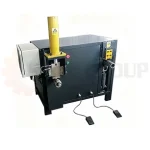In today’s world of automotive manufacturing and repair, sustainability and efficiency are key. One vital component that plays a significant role in this process is the automobile motor stator disassembly machine. But what exactly is it, and why is it crucial in the motor recycling industry? Whether you’re a manufacturer, repair shop owner, or someone interested in sustainable practices, this guide will explain how these machines work, their benefits, and why they are becoming increasingly important. By the end of this article, you’ll not only have a clear understanding of how these machines can optimize operations but also how they can save costs and reduce environmental impact.
What is an Automobile Motor Stator Disassembly Machine?
An automobile motor stator disassembly machine is a specialized piece of equipment used in the automotive industry for efficiently dismantling stators from electric motors. The stator, a critical part of the motor, houses windings and is crucial for generating magnetic fields. This machine separates the stator from the rest of the motor components , allowing for effective recycling and reuse of materials.
The disassembly process is often automated, with robotic arms, hydraulic systems, and precise cutting tools used to extract the stator quickly and safely. The advanced machinery ensures that the materials—typically copper, aluminum, and steel—are separated cleanly for reuse, significantly reducing waste in motor production and repair.
automobile motor stator disassembly machine?
Why are Automobile Motor Stator Disassembly Machines Important?
1. Sustainability at Its Core
Sustainability is a buzzword in the automotive industry, and rightly so. The automotive sector is under increasing pressure to reduce waste and increase the recycling of materials. With millions of motors in use worldwide, many eventually reach their end-of-life stage. The disassembly of motors, particularly the stator, allows valuable materials to be salvaged, reducing the need for new raw materials and minimizing environmental pollution.
2. Enhancing Efficiency in Motor Recycling
For businesses involved in motor recycling, time is money. Traditional methods of disassembling motors by hand are labor-intensive, prone to errors, and slow. An automobile motor stator disassembly machine streamlines the process, performing tasks like cutting and unwinding with precision, significantly improving throughput. This automation reduces operational costs and increases productivity.
3. Boosting Profitability
By investing in an automobile motor stator disassembly machine, businesses can recover precious metals and components that may otherwise be lost in the disassembly process. For example, copper, which is used extensively in the windings of stators, can be sold at a high price, ensuring that recycling remains profitable. This machine also lowers the cost of labor, reducing the overall cost of production and waste disposal.
How Does the Machine Work?
The operation of a motor stator disassembly machine is highly technical. Here’s a basic rundown of the process:
- Loading the Motor: The motor is placed into the disassembly machine,
- Separation of Stator and Rotor: Using advanced cutting or hydraulic techniques, the machine first separates the stator from the rotor. This step is crucial as the rotor may contain materials that are difficult to recycle.
- Unwinding of the Windings: The stator is unwound or stripped of its copper or aluminum windings using precision machinery. The winding removal process is carefully controlled to avoid damage to the materials, ensuring they are of high quality for resale.
- Final Sorting: After the windings are removed, the stator is separated into individual components, such as copper wire, steel, and other materials, which are then sent to specialized recycling processes.
The automobile motor stator disassembly machine is a game-changer for businesses in the automotive repair and recycling industries. By automating the process of stator disassembly, companies can streamline operations, boost sustainability efforts, and improve profitability. Investing in such a machine not only benefits your business but also contributes to a cleaner, more sustainable environment. Whether you’re looking to reduce waste, recover valuable materials, or improve operational efficiency, this technology offers a promising solution.
